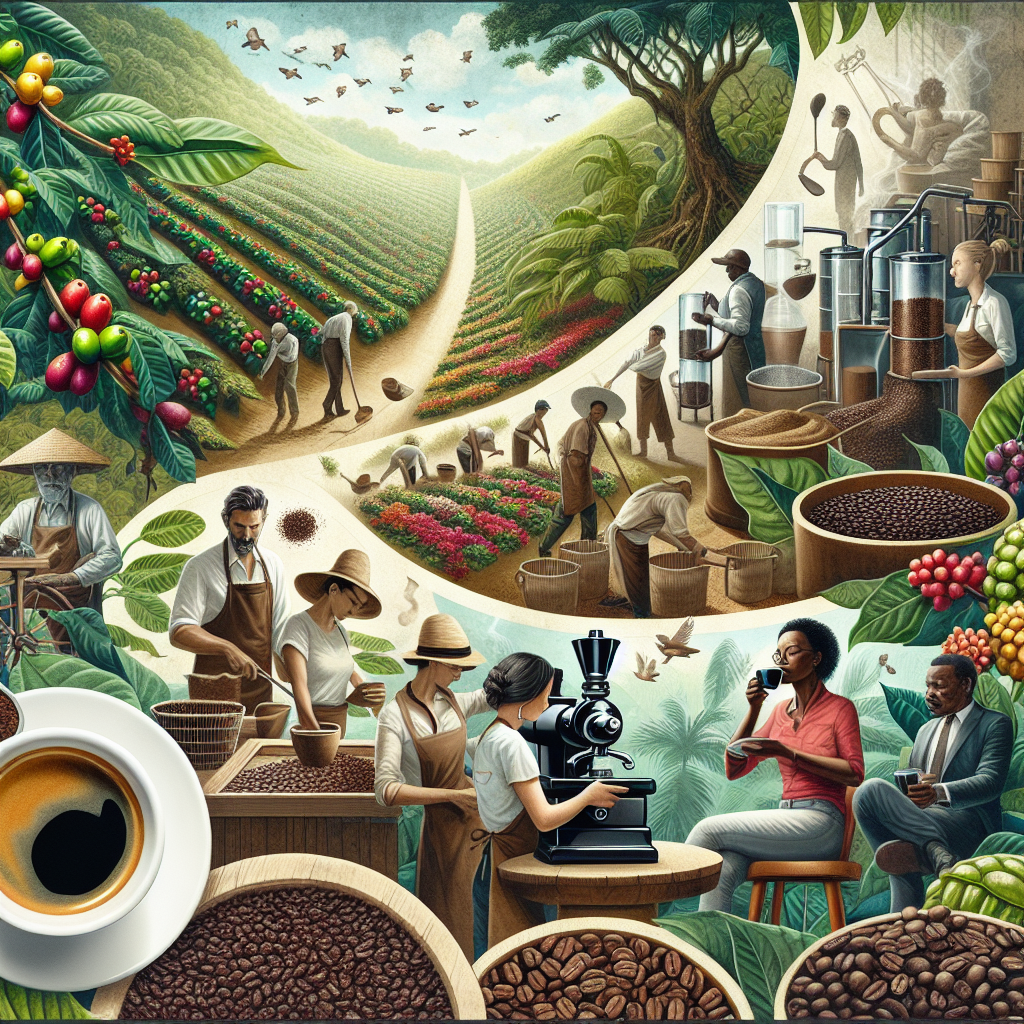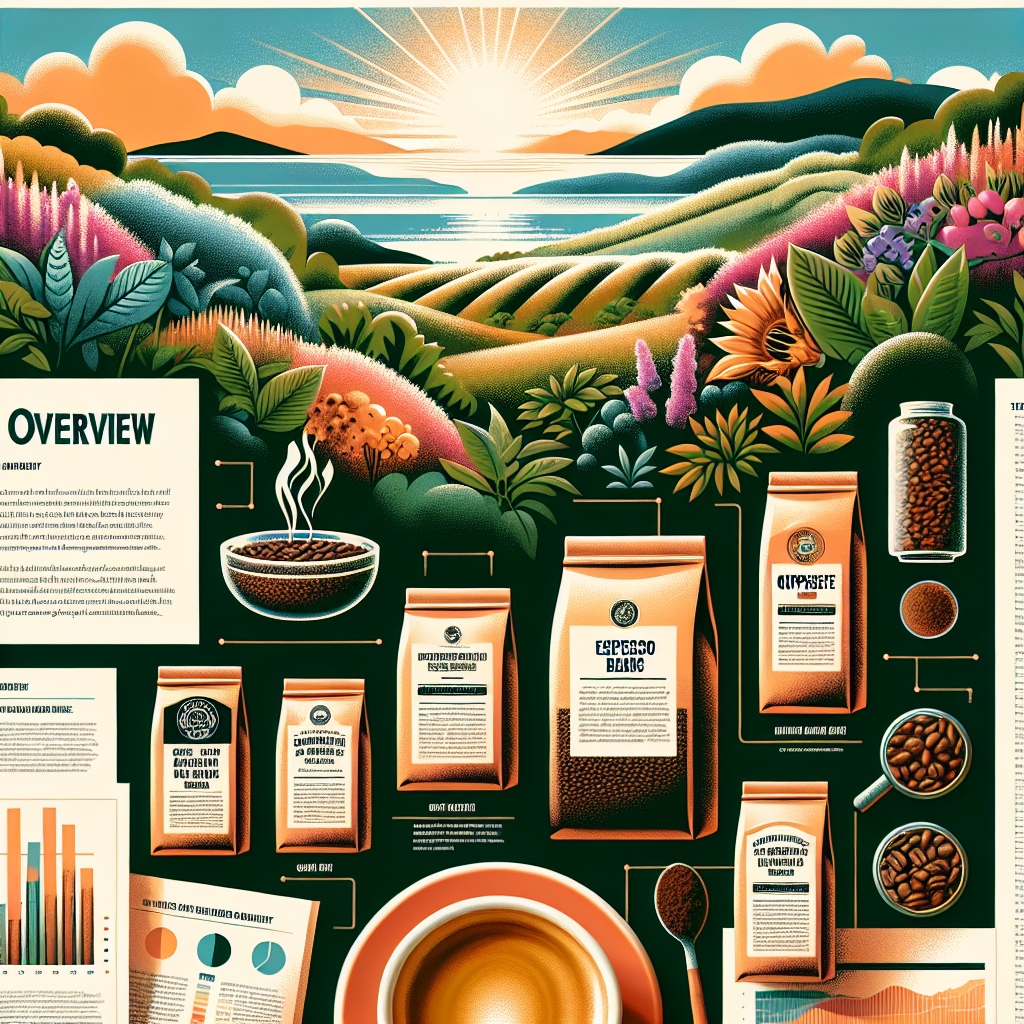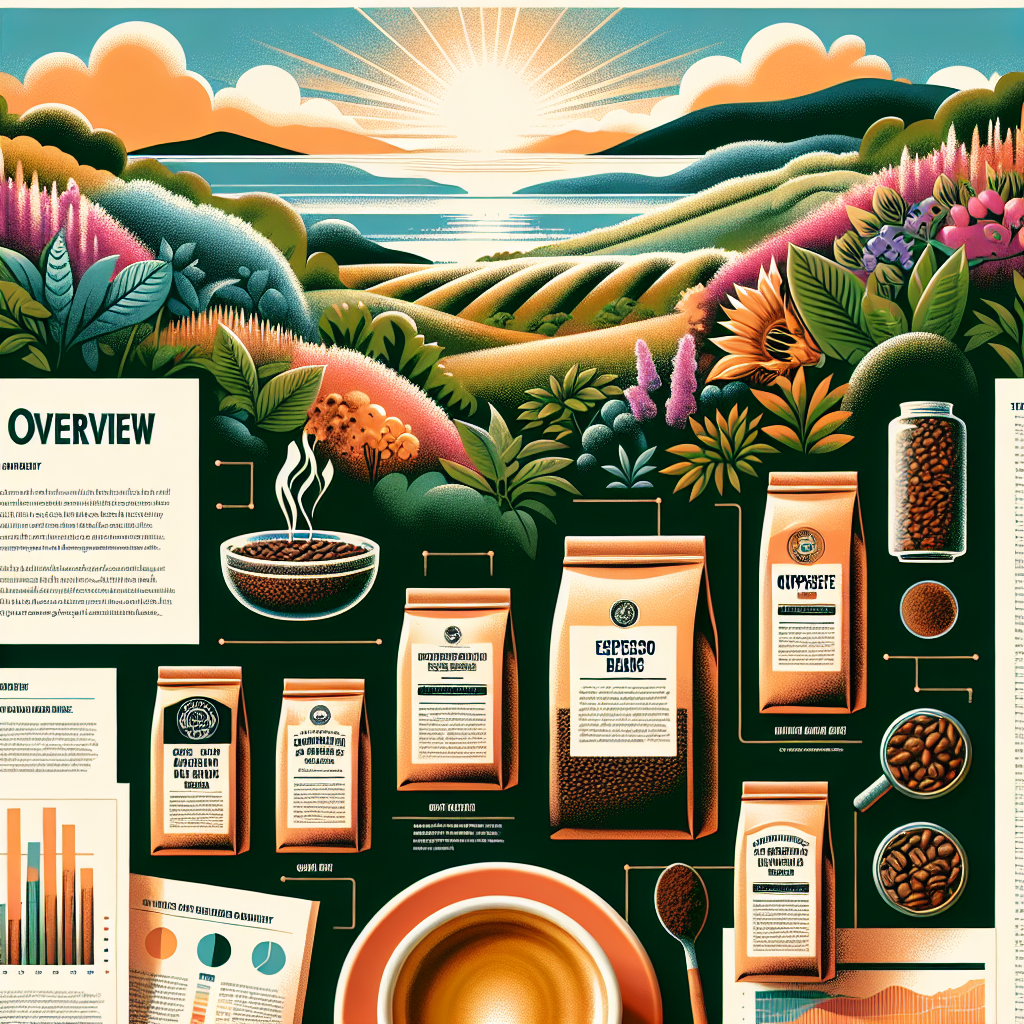You love your morning cup of espresso, and you’re always on the lookout for that perfect blend that will awaken your senses and provide that rich, indulgent flavor you crave. With so many options available, it can be overwhelming to choose which espresso beans to try. That’s why we’ve done the research for you and compiled a list of the most popular espresso beans among coffee enthusiasts. Whether you prefer a bold and smoky taste or a smooth and fruity flavor, we’ve got you covered. Let’s dive in and discover the beans that will elevate your espresso experience to new heights.

1. Arabica Beans
Arabica beans are widely regarded as the superior choice for coffee enthusiasts, and for good reason. They are known for their delicate and nuanced flavors, often having notes of fruity, floral, and even chocolatey undertones. Arabica beans also contain less caffeine than Robusta beans, making them a suitable choice for those who want a milder, yet flavorful cup of coffee.
1.1 Ethiopian Yirgacheffe
Ethiopian Yirgacheffe is a popular Arabica coffee variety that hails from the birthplace of coffee itself. It is revered for its distinctively bright acidity and a complex flavor profile that includes notes of citrus, jasmine, and a subtle hint of blueberry. The beans are grown in high altitudes in the Southern Ethiopian region of Yirgacheffe, which contributes to their exceptional quality.
1.2 Colombian Supremo
Colombian Supremo is another highly sought-after Arabica bean variety, originating from the coffee-rich country of Colombia. These beans are known for their medium body and balanced flavor, often characterized by caramel and nutty undertones. Colombian Supremo is grown in the high-altitude regions of Colombia, which enhances the beans’ acidity and robustness.
1.3 Brazilian Santos
Brazilian Santos is a popular Arabica coffee variety that accounts for a significant portion of the world’s coffee production. These beans are known for their smooth and mild flavor profile, which includes notes of chocolate, nuts, and a subtle acidity. Brazilian Santos beans are grown in various regions across Brazil, taking advantage of the country’s favorable climate and fertile soil.
2. Robusta Beans
While Arabica beans may be the preferred choice for many coffee enthusiasts, Robusta beans also hold their own in the world of coffee. Robusta beans are known for their higher caffeine content, bold flavors, and stronger body. They are often used in espresso blends to add depth and intensity to the final cup of coffee.
2.1 Vietnamese Robusta
Vietnamese Robusta has gained popularity in recent years due to its strong and full-bodied flavor profile. These beans are known for their earthy and chocolaty undertones, often with a hint of bitterness. Vietnam, one of the world’s largest coffee producers, cultivates these Robusta beans in its fertile highland regions, resulting in a rich and robust coffee experience.
2.2 Indonesian Robusta
Indonesia is another noteworthy producer of Robusta beans, and Indonesian Robusta has earned its place in the coffee world. These beans are known for their bold and intense flavors, often with earthy and woody notes. Coffee enthusiasts appreciate Indonesian Robusta for its ability to provide a strong caffeine kick and a characteristic, full-bodied taste.
2.3 Indian Robusta
India is a significant player in the world of coffee, and Indian Robusta beans have earned their reputation among coffee enthusiasts. These beans are known for their spicy and smoky flavors, often with hints of chocolate and nuts. Indian Robusta is cultivated in the southern regions of India, where the tropical climate and rich soil contribute to the beans’ distinctive taste and aroma.
3. Single-Origin Beans
Single-origin beans refer to coffee beans that come from a specific region or country, allowing coffee enthusiasts to experience the unique flavors and characteristics of that particular location. These beans offer a more focused and authentic coffee experience, showcasing the terroir and craftsmanship involved in their cultivation.
3.1 Ethiopian Sidamo
Ethiopian Sidamo is a sought-after single-origin coffee that offers a taste of Ethiopia’s rich coffee heritage. These beans are known for their medium body and vibrant acidity, often accompanied by fruity and floral notes. Sidamo is grown in the high-altitude regions of Ethiopia, where the fertile soil and optimal weather conditions contribute to the beans’ exceptional quality.
3.2 Costa Rican Tarrazu
Costa Rican Tarrazu is a single-origin coffee that comes from the Tarrazu region of Costa Rica. These beans are known for their bright acidity, medium body, and a flavor profile that often features citrus, berry, and chocolate undertones. The Tarrazu region’s high altitudes and volcanic soil create the ideal conditions for cultivating exceptional coffee beans.
3.3 Guatemalan Antigua
Guatemalan Antigua is a single-origin coffee variety that is highly regarded for its complex flavors and exceptional quality. These beans are grown in the renowned Antigua region of Guatemala, which is known for its volcanic soil and cool climate. Guatemalan Antigua beans offer a medium body with a balanced acidity and delightful flavors of cocoa, caramel, and even a hint of spice.
4. Blended Beans
Blended beans combine different coffee varieties to create a unique and well-balanced flavor profile. Coffee blends often aim to highlight the best characteristics of each bean, resulting in a harmonious and enjoyable drinking experience.
4.1 Italian Roast Blend
Italian Roast Blend is a popular choice among espresso lovers who prefer a bold and intense flavor profile. This blend typically incorporates a combination of darkly roasted Arabica and Robusta beans, resulting in a robust and earthy taste. Italian Roast blends are often characterized by their full body, rich crema, and lingering aftertaste.
4.2 Espresso Blend
Espresso Blend is designed specifically for brewing espresso, combining different coffee varieties to achieve a well-rounded taste. These blends often feature a combination of Arabica and Robusta beans, balancing acidity, body, and flavor. Espresso blends can vary widely in flavor profile, ranging from bright and fruity to smooth and chocolaty, offering a variety of options to suit different preferences.
4.3 French Roast Blend
French Roast Blend is a dark and intense coffee blend that is popular among those who prefer strong and smoky flavors. This blend typically includes darkly roasted Arabica and Robusta beans that lend a bold and bittersweet taste. French Roast blends are known for their heavy body, low acidity, and a rich aroma that fills the room.

5. Dark Roast Beans
Dark roast beans undergo an extended roasting process, resulting in a deep, dark color and intense flavor. These beans are often chosen by coffee enthusiasts who enjoy a strong, full-bodied cup of coffee with a rich and robust taste.
5.1 Italian Roast
Italian Roast is a dark roast coffee variety known for its bold and complex flavors. These beans are roasted until they reach a deep, oily sheen, enhancing their natural characteristics. Italian Roast beans offer a heavy body, low acidity, and a strong, smoky taste that lingers on the palate, often accompanied by notes of dark chocolate and caramel.
5.2 French Roast
French Roast is another popular dark roast option, characterized by its deep and rich flavors. These beans are roasted until they develop a shiny, oily surface, resulting in a pronounced bitterness and a smoky aroma. French Roast beans offer a heavy body, low acidity, and flavors reminiscent of dark chocolate, roasted nuts, and even a touch of char.
5.3 Spanish Roast
Spanish Roast is the darkest roast level available, offering an incredibly bold and intense coffee experience. These beans are roasted until they reach a near-black color, developing a shiny and oily surface. Spanish Roast beans are known for their extremely low acidity, full body, and flavors of dark chocolate, burnt caramel, and even a hint of tobacco.
6. Light Roast Beans
Light roast beans are roasted for a shorter period, allowing the unique characteristics of the coffee beans to shine through. These beans offer a more delicate and nuanced flavor profile, often showcasing the coffee’s natural acidity and bright, fruity notes.
6.1 Ethiopian Yirgacheffe
Ethiopian Yirgacheffe, mentioned earlier as an Arabica bean variety, is also popular as a light roast coffee. Lightly roasting these beans accentuates their bright acidity and brings forward the complex flavors of citrus, jasmine, and blueberry. Yirgacheffe light roast offers a lighter body, higher acidity, and a clean, refreshing finish.
6.2 Costa Rican Tarrazu
Costa Rican Tarrazu, another single-origin coffee variety, is equally delightful when roasted to a light level. This roast brings out the vibrant acidity and highlights the coffee’s zesty citrus notes, berry undertones, and even a hint of chocolate. Light roast Tarrazu beans offer a medium body, a satisfying brightness, and a well-balanced flavor profile.
6.3 Guatemalan Antigua
Guatemalan Antigua, mentioned earlier as a single-origin coffee variety, shines as a light roast as well. Lightly roasting these beans allows their intricate flavors of cocoa, caramel, and spice to come to the forefront. Antigua light roast boasts a medium body, a medium-high acidity, and a delightful combination of sweetness and subtle spice.
7. Fair Trade Beans
Fair trade beans are coffee beans that have been certified by organizations that ensure fair prices and better working conditions for coffee farmers. These beans are often sourced from small-scale farmers, empowering them economically and promoting sustainable practices within the coffee industry.
7.1 Ethiopian Yirgacheffe
Ethiopian Yirgacheffe beans, known for their exceptional flavor profile, are also available as fair trade coffee. By choosing fair trade Ethiopian Yirgacheffe, you can enjoy your cup of coffee knowing that the farmers who grew these beans are receiving fair compensation for their hard work, leading to improved economic conditions within their communities.
7.2 Colombian Supremo
Colombian Supremo, mentioned earlier as an Arabica bean variety, is also available as fair trade coffee. By opting for fair trade Colombian Supremo, you can support Colombian farmers and contribute to sustainable development in their regions. These beans offer a win-win situation, as you can enjoy the rich flavors of Colombian coffee while making a positive impact on the lives of farmers.
7.3 Brazilian Santos
Brazilian Santos, another popular Arabica bean variety, is also available as fair trade coffee. By choosing fair trade Brazilian Santos, you can support Brazilian coffee farmers and ensure that they receive fair compensation for their hard work. These beans offer a smooth and mild flavor profile, combined with the satisfaction of knowing that your coffee purchase is making a difference.
8. Organic Beans
Organic beans are coffee beans that have been grown without the use of synthetic fertilizers, pesticides, or genetically modified organisms (GMOs). They are cultivated using sustainable and environmentally friendly practices, ensuring that the coffee you enjoy is free from harmful chemicals.
8.1 Ethiopian Sidamo
Ethiopian Sidamo, mentioned earlier as a single-origin coffee variety, is also available as organic coffee. By choosing organic Ethiopian Sidamo, you can savor the distinctive flavors of these beans while supporting eco-friendly farming practices. These organic beans offer a medium body, vibrant acidity, and a flavor profile enriched with fruity and floral notes.
8.2 Costa Rican Tarrazu
Costa Rican Tarrazu, known for its bright acidity and delightful flavor profile, is also available as organic coffee. By opting for organic Tarrazu beans, you can enjoy the coffee’s zesty citrus notes, berry undertones, and silky chocolate flavors, all while contributing to a more sustainable coffee industry.
8.3 Guatemalan Antigua
Guatemalan Antigua, mentioned earlier as a single-origin coffee variety, is also available as organic coffee. By choosing organic Antigua beans, you can relish the coffee’s complex flavors of cocoa, caramel, and spice, knowing that your coffee purchase supports environmentally friendly farming methods. These organic beans offer a medium body, a medium-high acidity, and a satisfying balance of sweetness and subtle spice.
9. Specialty Beans
Specialty beans are the crème de la crème of the coffee world, representing the highest quality and most exceptional flavors. These beans are carefully selected, roasted with precision, and brewed with the utmost care to ensure the best possible coffee experience.
9.1 Blue Mountain
Blue Mountain coffee is considered one of the most prestigious and sought-after specialty coffee varieties in the world. These beans originate from the Blue Mountains of Jamaica, where they are grown in high altitudes and under specific weather conditions. Blue Mountain beans are known for their smooth and mild flavor profile, combined with a delightful sweetness and subtle hints of spice.
9.2 Hawaiian Kona
Hawaiian Kona coffee is another renowned specialty coffee variety that comes from the volcanic slopes of the Kona region in Hawaii. These beans thrive in the unique microclimate of the Kona region, producing a coffee with a rich and complex flavor profile. Kona beans are often praised for their smoothness, low acidity, and flavors of caramel, chocolate, and tropical fruits.
9.3 Geisha
Geisha (also spelled Gesha) coffee is highly regarded for its exceptional quality and its unique flavor profile. These beans originated in Ethiopia and are now cultivated in various regions worldwide. Geisha beans are known for their bright acidity, complex floral and tea-like flavors, and an enchanting aroma that captivates coffee enthusiasts.
10. Sustainable Beans
Sustainable beans refer to coffee beans that have been produced using environmentally friendly practices and support the long-term well-being of coffee-growing regions. They often involve sustainable farming techniques, fair wages for farmers, and social initiatives aimed at enhancing the communities involved in the coffee production process.
10.1 Ethiopian Sidamo
Ethiopian Sidamo beans, previously mentioned in various categories, are also recognized for their sustainable cultivation practices. The farmers who grow these beans prioritize protecting the environment and implementing sustainable farming techniques. By choosing Sidamo beans, you can enjoy your coffee with peace of mind, knowing that you are supporting the well-being of the coffee-growing community in Ethiopia.
10.2 Colombian Supremo
Colombian Supremo beans, mentioned earlier as an Arabica bean variety, are also available as sustainable coffee. Colombia has made significant efforts to promote sustainable coffee production, focusing on implementing eco-friendly agricultural practices and supporting the well-being of coffee farmers. By choosing Colombian Supremo beans, you can savor the flavors of Colombian coffee while contributing to a sustainable coffee industry.
10.3 Brazilian Santos
Brazilian Santos beans, previously discussed, are also recognized for their sustainable cultivation practices. Brazil, being one of the largest coffee producers globally, has been proactive in implementing sustainable farming practices aimed at preserving the environment and supporting coffee farming communities. By choosing Brazilian Santos beans, you can enjoy your cup of coffee while supporting sustainable initiatives within the coffee industry.
In conclusion, the world of espresso beans offers a vast array of options to cater to every coffee enthusiast’s taste and preferences. Whether you lean towards the delicate and nuanced flavors of Arabica beans, the boldness of Robusta beans, or the unique characteristics of single-origin, blended, dark roast, or light roast beans, there is a coffee variety to suit your palate. You can also choose beans that align with your values, such as fair trade, organic, specialty, and sustainable options. So, go ahead, explore, and savor the rich and aromatic world of espresso beans.

